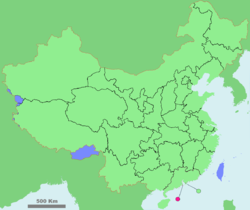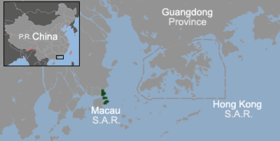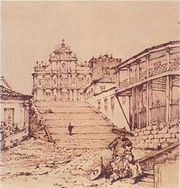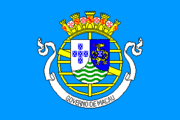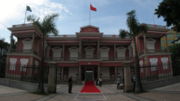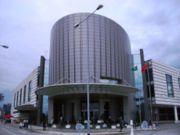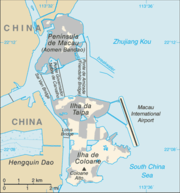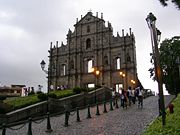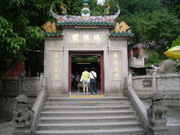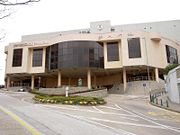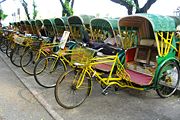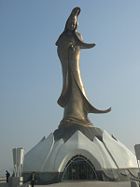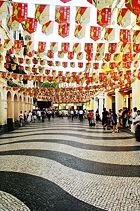Macau
2008/9 Schools Wikipedia Selection. Related subjects: Geography of Asia
| 澳門特別行政區 Região Administrativa Especial de Macau Macau Special Administrative Region |
||||||
|---|---|---|---|---|---|---|
|
||||||
| Anthem: March of the Volunteers |
||||||
|
|
||||||
|
|
||||||
| Largest freguesia (population) | Freguesia de Nossa Senhora de Fátima | |||||
| Official languages | Portuguese, Chinese, Cantonese, | |||||
| Demonym | Macanese | |||||
| Government | ||||||
| - | Chief Executive | Edmund Ho Hau-wah | ||||
| Establishment | ||||||
| - | Portugal-administered trading post | 1557 | ||||
| - | Portuguese colony | December 1, 1887 | ||||
| - | Transfer of sovereignty to the PRC |
December 20, 1999 |
||||
| Area | ||||||
| - | Total | 28.6 km² ( not ranked) 11.04 sq mi |
||||
| - | Water (%) | 0 | ||||
| Population | ||||||
| - | 2007 (1st qtr) estimate | 520,400 ( 167th) | ||||
| - | 2000 census | 431,000 | ||||
| - | Density | 17,310/km² ( 1st) 44,784/sq mi |
||||
| GDP ( PPP) | 2006 estimate | |||||
| - | Total | US$17,600 m ( 99th) | ||||
| GDP (nominal) | 2007 estimate | |||||
| - | Total | US$15,997 m ( 94th) | ||||
| - | Per capita | US$36,357 | ||||
| HDI (2004) | ▬0.909 (high) ( 25th) | |||||
| Currency | Macanese pataca ( MOP) |
|||||
| Time zone | MST ( UTC+8) | |||||
| Internet TLD | .mo | |||||
| Calling code | +853 | |||||
The Macau Special Administrative Region, commonly known as Macau or Macao (IPA: /mækaʊ/, traditional Chinese: 澳 門; simplified Chinese: 澳 门; pinyin: Aòmén; jyutping: ou3 mun4), is one of the two special administrative regions of the People's Republic of China, the other being Hong Kong. Macau lies on the western side of the Pearl River Delta, bordering Guangdong province in the north and facing the South China Sea in the east and south. The territory has thriving industries such as textiles, electronics and toys, and a notable tourist industry that boasts a wide range of hotels, resorts, stadiums, restaurants and casinos.
Macau was both the first and the last European colony in China. Portuguese traders first settled in Macau in the 16th century and subsequently administered the region until the handover on December 20, 1999. The Sino-Portuguese Joint Declaration and the Basic Law of Macau stipulate that Macau operates with a high degree of autonomy until at least 2049, fifty years after the transfer. Under the policy of " one country, two systems", the Central People's Government is responsible for the territory's defense and foreign affairs, while Macau maintains its own legal system, police force, monetary system, customs policy, immigration policy, and delegates to international organisations and events.
Etymology
Before the Portuguese settlement in the early 16th century, Macau was known as Haojing (Oyster Mirror) or Jinghai (Mirror Sea). The name Macau is thought to be derived from the Templo de A-Má, a temple built in 1448 dedicated to Matsu - the goddess of seafarers and fishermen. It is said that when the Portuguese sailors landed at the coast just outside the temple and asked the name of the place, the natives replied "A-Ma-Gao" (Bay of A-Ma). The Portuguese then named the peninsula Macau.
History
The recorded history of Macau can be traced back to the Qin Dynasty (221–206 BC), when the region now called Macau came under the jurisdiction of Panyu County, Nanhai Prefecture of the province of Guangdong. The first recorded inhabitants of the area were people seeking refuge in Macau from invading Mongols, during the Southern Song Dynasty. Later in the Ming Dynasty (1368–1644 AD), fishermen migrated to Macau from various parts of Guangdong and Fujian provinces. However, Macau did not develop as a major settlement until the Portuguese arrived in the 16th century. In 1535, the Portuguese traders obtained the rights to anchor ships in Macau's harbours and the right to carry out trading activities, though not the right to stay onshore. Around 1552–1553, they obtained a temporary permission to erect storage sheds onshore, in order to dry out goods drenched by sea water. They later built some rudimentary stone-houses around the area now called Nam Van. In 1557, the Portuguese establish a permanent settlement in Macau, at an annual rent of 500 taels of silver.
Since then, more Portuguese settled in Macau to engage in trading activities, and there were demands for self-administration, but did not achieved until 1840s. In 1576, Macau was established as an episcopal see by Pope Gregory XIII. In 1583, the Portuguese in Macau were permitted to form a Senate to handle various issues concerning their social and economic affairs under strict supervision of the Chinese authority, but there was no transfer of sovereignty. Macau prospered as a port but was the target of repeated failed attempts by the Dutch to conquer it in the 17th century. Following the Opium War (1839–42), Portugal occupied Taipa and Coloane in 1851 and 1864 respectively. In 1887, the Qing government was forced to sign the Sino-Portuguese Treaty of Amity and Commerce, under which China ceded to Portugal the right of "perpetual occupation and government of Macau"; conversely, Portugal pledged to seek China's approval before transferring Macau to another country. Macau officially became a Portuguese colony.
After the Qing Dynasty was overthrown following the Xinhai Revolution, in 1928 the Kuomintang government officially notified Portugal that it was abrogating the former treaty, and in its place the Sino-Portuguese Friendship and Trade Treaty was signed. Making only a few provisions concerning tariff principles and matters relating to business affairs, the treaty failed to mention the question with regard to the sovereignty of Macau. Consequently, the situation of Portuguese occupation and government of Macau remained unchanged. After the establishment of the People's Republic of China in 1949, the Beijing government declared the Sino-Portuguese Treaty of Amity and Commerce to be invalid as an “ unequal treaty” imposed by foreigners on China. However, Beijing was not ready to settle the treaty question, leaving the maintenance of “the status quo” until a more appropriate time.
In 1966, with the general dissatisfaction of the Portuguese government and under the influence of the Cultural Revolution in mainland China, more serious riots broke out in Macau. The most serious one is the so-called 12-3 incident that resulted in more than 200 people killed or injured. On January 28, 1967 the Portuguese government signed a statement of apology. This marked the beginning of equal treatment and recognition of Chinese identity and of de facto Chinese control of the colony, as an official apology underlined the fact that after 1949, administration of Macau continued only at the behest of the mainland communist government. Shortly after the Carnation Revolution leftist military coup of 1974 in Lisbon, the newly assigned government of Portugal was determined to relinquish all its overseas possessions. In 1976, Lisbon redefined Macau as a "Chinese territory under Portuguese administration," and granted it a large measure of administrative, financial and economic autonomy. Portugal and China agreed in 1979 to regard Macau as "a Chinese territory under (temporary) Portuguese administration". Negotiations between the Chinese and Portuguese governments on the question of Macau started in June 1986. In 1987, an international treaty, known as the Sino-Portuguese Joint Declaration, was signed to make Macau a special administrative region of China. The Chinese government assumed sovereignty over Macau on December 20, 1999.
Government and politics
The Sino-Portuguese Joint Declaration and the Basic Law, Macau's constitution promulgated by China's National People's Congress in 1993, specify that Macau's social and economic system, lifestyle, rights, and freedoms are to remain unchanged for at least 50 years after the transfer of sovereignty to China in 1999. Under the principle of "one country, two systems", Macau enjoys a high degree of autonomy in all areas except in defence and foreign affairs. Macau officials, rather than PRC officials, run Macau through the exercise of separate executive, legislative, and judicial powers, as well as the right to final adjudication. Macau maintains its own separate currency, customs territory, immigration and border controls, and police force.
The Macau government is headed by the chief executive, who is appointed by the central government upon the recommendation of an election committee, whose three hundred members are nominated by corporate and community bodies. The recommendation is made by an election within the committee. The chief executive's cabinet comprise five policy secretaries and is advised by the Executive Council that has between seven and eleven members. Edmund Ho Hau Wah, a community leader and former banker, is the first chief executive of the Macau SAR, replacing General Vasco Rocha Vieira at midnight on December 20, 1999. Ho is currently serving his second term of office.
The legislative organ of the territory is the Legislative Assembly, a 29-member body comprising 12 directly elected members, ten indirectly elected members representing functional constituencies and seven members appointed by the chief executive. Any permanent residents at or over 18 years of age are eligible to vote in direct elections. For indirect election, it is only limited to organisations registered as "corporate voters" and a 300-member election committee drawn from broad regional groupings, municipal organisations, and central governmental bodies. The basic and original framework of the legal system of Macau, based largely on Portuguese law or Portuguese civil law system, is preserved after 1999. The territory has its own independent judicial system, with a high court. Judges are selected by a committee and appointed by the chief executive. Foreign judges may serve on the courts. Macau has a three-tier court system: the Court of the First Instance, the Court of the Second Instance and the Court of Final Appeal.
Geography
Macau is situated 60 kilometres (37 mi) southwest of Hong Kong and 145 kilometres (90 mi) from Guangzhou. It consists of the Macau Peninsula itself and the islands of Taipa and Coloane. The peninsula is formed by the Zhujiang (Pearl River) estuary on the east and the Xijiang (West River) on the west. It borders the Zhuhai Special Economic Zone in mainland China. The main border crossing between Macau and China is known as the Portas do Cerco (Barrier Gate) on the Macau side, and the Gongbei checkpoint on the Zhuhai side. Macau Peninsula was originally an island, but a connecting sandbar gradually turned into a narrow isthmus, thus changing Macau into a peninsula. Land reclamation in the 17th century transformed Macau into a peninsula with generally flat terrain, though numerous steep hills still mark the original land mass. Alto de Coloane is the highest point in Macau, with an altitude of 170.6 metres (559.7 ft). With a dense urban environment, Macau has no arable land, pastures, forest, or woodland.
Macau has a humid subtropical climate, with average humidity between 75% and 90%. Seasonal climate is greatly influenced by the monsoons and therefore temperature difference between summer and winter is significant. The average annual temperature of Macau is 22.3 °C (72.1 °F). July is the warmest month, with average temperature being 28.6 °C (83.5 °F). The coolest month is January, with average temperature 14.5 °C (58.1 °F). Located in the coastal region of south of China, Macau has ample rainfall, with average annual precipitation being 2,030 millimetres (80 in). However, winter is mostly dry due to the monsoon from mainland China. Autumn in Macau (i.e. October to December) is sunny and warm with low humidity. Winter (i.e. January to March) is relatively cold but sunny. In spring (i.e. start from April), the humidity starts to increase and in summer (i.e. May to September) the climate is warm to hot and humid with rain and occasional typhoons.
| Weather averages for Macau | |||||||||||||
|---|---|---|---|---|---|---|---|---|---|---|---|---|---|
| Month | Jan | Feb | Mar | Apr | May | Jun | Jul | Aug | Sep | Oct | Nov | Dec | Year |
| Average high °C (°F) | 18 (64) | 18 (64) | 21 (70) | 24 (75) | 28 (82) | 31 (88) | 32 (90) | 32 (90) | 30 (86) | 28 (82) | 24 (75) | 19 (66) | 25.4 (78) |
| Average low °C (°F) | 13 (55) | 13 (55) | 16 (61) | 20 (68) | 24 (75) | 26 (79) | 27 (81) | 27 (81) | 26 (79) | 23 (73) | 18 (64) | 14 (57) | 20.5 (69) |
| Precipitation mm (inches) | 32.4 (1.3) | 58.8 (2.3) | 82.5 (3.2) | 217.4 (8.6) | 361.9 (14.2) | 339.7 (13.4) | 289.8 (11.4) | 351.6 (13.8) | 194.1 (7.6) | 116.9 (4.6) | 42.6 (1.7) | 35.2 (1.4) | 2,122.9 (83.6) |
| Source: WMO - Macau 2007-11-12 | |||||||||||||
Economy
| Employed population by occupation 2007 |
||
|---|---|---|
| Occupation | no. ('000) |
|
| Senior officials/managers | 14.6 | |
| Professionals | 9.9 | |
| Technicians | 28.1 | |
| Clerks | 83.7 | |
| Service & sale workers | 63.2 | |
| Workers in agriculture/fishery | 0.8 | |
| Craft & similar workers | 33.7 | |
Macau's economy is based largely on tourism, much of it geared toward gambling. Other chief economic activities in Macau are export-geared textile and garment manufacturing, banking and other financial services. The clothing industry has provided about three quarters of export earnings, and the gaming, tourism and hospitality industry is estimated to contribute more than 50% of Macau's GDP, and 70% of Macau government revenue.
Macau is a founding member of the WTO and has maintained sound economic and trade relations with more than 120 countries and regions, with European Union and Portuguese-speaking countries in particular; Macau is also a member of the IMF. World Bank classifies Macau as a high income economy and the GDP per capita of the region in 2006 was US$28,436. After the Handover in 1999, there has been a rapid rise in the number of mainland visitors due to China's easing of travel restrictions. Together with the liberalization of Macau's gaming industry in 2001 that induces significant investment inflows, the average growth rate of the economy between 2001 and 2006 is approximately 13.1% annually.
In a World Tourism Organization report of international tourism statistics for 2006, Macau ranked 21st in terms of tourist arrivals and 24th in terms of tourism receipts. From 9.1 million visitors in 2000, arrivals to Macau has grown to 18.7 million visitors in 2005 and 22 million visitors in 2006, with over 50% of the arrivals coming from mainland China and another 30% from Hong Kong. Macau is expected to receive between 24 and 25 million visitors in 2007. Since the Handover, Triad underworld violence, a deterring factor for tourists, has virtually disappeared, to the benefit of the tourism sector.
Starting in 1962, the gambling industry had been operated under a government-issued monopoly license by Stanley Ho's Sociedade de Turismo e Diversões de Macau. The monopoly ended in 2002, and several casino owners from Las Vegas attempted to enter the market. With the opening of the Sands Macau, the largest casino in the world as measured by total number of table games, in 2004 and Wynn Macau in 2006, gambling revenues from Macau's casinos were for the first time greater than those of Las Vegas Strip (each about $6 billion), making Macau the highest-volume gambling centre in the world. In 2007, Venetian Macau, the second largest building in the world, opened its doors to the public, followed by MGM Grand Macau. Numerous other hotel casinos, including Galaxy Cotai Megaresort and Ponte 16, are also to be opened in the near future.
In 2002, the Macau government ended the monopoly system and six casino operating concessions and subconcessions are granted to Sociedade de Turismo e Diversões de Macau, Wynn Resorts, Las Vegas Sands, Galaxy Entertainment Group, the partnership of MGM Mirage and Pansy Ho Chiu-king, and the partnership of Melco and PBL. Today, there are 16 casinos operated by the STDM, and they are still crucial in the casino industry in Macau, but in 2004, the opening of the Sands Macau ushered in the new era.
Macau is an offshore financial centre, a tax haven, and a free port with no foreign exchange control regimes. The offshore finance business is regulated and supervised by the Monetary Authority of Macau, while the regulation and supervision of the offshore non-finance business is mainly controlled by the Macau Trade and Investment Promotion Institute. In 2007, Moody's Investors Service upgraded Macau's foreign and local currency government issuer ratings to 'Aa3' from 'A1', citing its government's solid finances as a large net creditor. The rating agency also upgraded Macau's foreign currency bank deposit ceiling to 'Aa3' from 'A1'.
As prescribed by the Macau Basic Law, the government follows the principle of keeping expenditure within the limits of revenues in drawing up its budget, and strive to achieve a fiscal balance, avoid deficits and keep the budget commensurate with the growth rate of its gross domestic product. All the financial revenues of the Macau Special Administrative Region shall be managed and controlled by the Region itself and shall not be handed over to the Central People's Government. The Central People's Government shall not levy any taxes in the Macau Special Administrative Region.
Demographics
| Residents' usual language spoken at home |
|
|---|---|
| Language | Percentage of population |
| Cantonese | 85.7% |
| Mandarin | 3.2% |
| Other Chinese dialects |
6.7% |
| Portuguese | 0.6% |
| English | 1.5% |
| Others | 2.3% |
Macau is the most densely populated region in the world, with a population density of 18,428 persons per square kilometre (47,728/sq mi). 95% percent of Macau's population is Chinese; another 2% is of mixed Chinese/Portuguese descent, an ethnic group often referred to as Macanese. According to the 2006 by-census, 47% of the residents were born in mainland China, of whom 74.1% born in Guangdong and 15.2% in Fujian. Meanwhile, 42.5% of the residents were born in Macau, and those born in Hong Kong, the Philippines and Portugal shared 3.7%, 2.0% and 0.3% respectively.
The growth of population in Macau mainly relies on immigrants from mainland China and the influx of overseas workers since its birth rate is one of the lowest in the world. According to a recent survey conducted by the U.S. Central Intelligence Agency (CIA), Macau is among the top 10 countries/regions with the highest life expectancy at birth, while its infant mortality rate ranks among the lowest in the world.
| Macau religiosity | ||||
|---|---|---|---|---|
| religion | percent | |||
| Taoism and Buddhism | 73% | |||
| Mahayana Buddhism | 17% | |||
| Christianity | 9% | |||
| Others | 1% | |||
Both Chinese ( Cantonese) and Portuguese are Macau's official languages. Standard Macanese Portuguese is identical to European Portuguese. Other languages such as Mandarin, English and Hokkien are also spoken by some local communities. The Macanese language, a distinctive creole generally known as Patuá, is still spoken by several dozen Macanese.
Most Chinese in Macau are profoundly influenced by their own tradition and culture, of which Chinese folk religion, that includes the faiths of Taoism, Buddhism and Confucianism, forms an integral part. Macau has a sizable Christian community; Roman Catholics and Protestants constitute 7% and 2% of the population respectively. In addition, 17% of the population follows distilled original Mahayana Buddhism.
Having an economy driven by tourism, 14.6% of Macau's workforce is employed in restaurants and hotels, and 10.3% in the gambling industry. With the opening of several casino resorts and other major constructions underway, it is reported that many sectors experience a shortage of labour. The government responds by importing labour from other neighboring regions.
Currently the number of imported labours stands at a record high of 75,391 (Q2 2007), representing more than a quarter of the labour force in Macau. Some local workers complain about the lack of jobs due to the influx of cheap imported labour. Some also claim that the problem of illegal labour is severe. Another concern is the widening of income inequality in the region: Macau's Gini coefficient, a popular measure of income inequality where a low value indicates a more equal income distribution, rises from 0.43 in 1998 to 0.48 in 2006. It is higher than those of other neighbouring regions, such as mainland China (0.447), South Korea (0.316) and Singapore (0.425)..
In 2007, there were a total of 4,537 births and 1,545 deaths.
Education
A fifteen-year free education is currently being offered to residents, that includes a three-year kindergarten, followed by a six-year primary education and a six-year secondary education. Despite the fifteen-year free education, the literacy rate of the territory is only 93.5%. The illiterates are, however, mainly among the senior residents aged 65 or above; the younger generation, for example the population aged 15-29, has a literary rate of above 99%. Currently, there is only one school in Macau where Portuguese is the medium of instruction.
Macau does not have its own universal education system; non-tertiary schools follow either the British, the Chinese, or the Portuguese education system. There are currently 10 tertiary educational institutions in the region, four of them being public. In 2006, the Programme for International Student Assessment, a world-wide test of 15-year-old schoolchildren's scholastic performance coordinated by OECD, ranked Macau as the fifth and sixth in science and problem solving respectively. Nevertheless, education levels in Macau are low among high income regions. According to the 2006 by-census, among the resident population aged 14 and above, only 51.8% has a secondary education and 12.6% has a tertiary education.
As prescribed by the Basic Law of Macau Chapter VI Article 121, the Government of Macau shall, on its own, formulate policies on education, including policies regarding the educational system and its administration, the language of instruction, the allocation of funds, the examination system, the recognition of educational qualifications and the system of academic awards so as to promote educational development. The government shall also in accordance with law, gradually institute a compulsory education system. Community organisations and individuals may, in accordance with law, run educational undertakings of various kinds.
Healthcare
Macau is served by one major public hospital, the Hospital Conde S. Januário, and one major private hospital, the Hospital Kiang Wu, both located in Macau Peninsula, as well as a university hospital called Macau University of Science and Technology Hospital in Cotai. In addition to hospitals, Macau also has numerous health centres providing free basic medical care to residents. Consultation in traditional Chinese medicine is also available. Currently none of the Macau hospitals is independently assessed through international healthcare accreditation. There are no western-style medical schools in Macau and thus all aspiring physicians in Macau have to obtain their education and qualification elsewhere. Local nurses are trained at the Macau Polytechnic Institute and the Kiang Wu Nursing College. Currently there are no training courses in midwifery in Macau.
The Health Bureau in Macau is mainly responsible for coordinating the activities between the public and private organisations in the area of public health, and assure the health of citizens through specialised and primary health care services, as well as disease prevention and health promotion. The Centre for Disease Control and Prevention was established in 2001, which monitors the operation of hospitals, health centres, and the blood transfusion centre in Macau. It also handles the organisation of care and prevention of diseases affecting the population, sets guidelines for hospitals and private health care providers, and issues licences.
Transport
While the traffic in mainland China drives on the right, in Macau traffic moves on the left. Macau has a well-established public transport network connecting the Macau Peninsula, Cotai, Taipa Island and Coloane Island. Buses and taxis are the major modes of public transport in Macau. Currently two companies, namely Transmac and Transportas Companhia de Macau, operate franchised public bus services in Macau. The trishaw, a hybrid of the tricycle and the rickshaw, is also available, though it is mainly for sightseeing purposes.
The Outer Harbour Ferry Terminal provides cross-border transportation services for passengers travelling between Macau and Hong Kong, while the Yuet Tung Terminal in the Inner Harbour serves those travelling between Macau and cities in mainland China, including Shekou and Shenzhen. Macau has one active international airport, known as Macau International Airport located at the eastern end of Taipa and neighbouring waters. Since currently there are no regular direct passenger-flights between mainland China and Taiwan, the airport serves as a transient avenue for the passengers travelling between the two regions. It is the primary hub for Viva Macau and Air Macau. In 2006, the airport handled about 5 million passengers.
Culture
The mixing of the Chinese and Portuguese cultures and religious traditions for more than four centuries has left Macau with an inimitable collection of holidays, festivals and events. The biggest event of the year is the Macau Grand Prix in November, when the main streets in Macau Peninsula are converted to a racetrack bearing similarities with the Monaco Grand Prix. Other annual events include Macau Arts festival in March, the International Fireworks Display Contest in September, the International Music festival in October and/or November, and the Macau International Marathon in December.
The Lunar Chinese New Year is the most important traditional festival and celebration normally takes place in late January or early February. The Pou Tai Un Temple in Taipa is the place for the Feast of Tou Tei, the Earth god, in February. The Procession of the Passion of Our Lord is a well-known Catholic rite and journey, which travels from Igreja de Santo Agostinho to Igreja da Sé Catedral, also taking place in February. A-Ma Temple, which honours the Goddess Matsu, is in full swing in April with many congratulant worshippers during the A-Ma festival. To look on dancing dragons at the Feast of the Drunken Dragon and twinkling-clean Buddhas at the Feast of Bathing of Lord Buddha in May is common. In Coloane Village, the Taoist god Tam Kong is also honoured on the same day. Dragon Boat festival is brought into play on Nam Van Lake in June and Hungry Ghosts' festival, in late August and/or early September every year. All events and festivities of the year end with Winter Solstice in December.
Local cooking in Macau consists of a blend of Cantonese and Portuguese cuisines. Many unique dishes resulted from the spice blends that the wives of Portuguese sailors used in an attempt to replicate European dishes. Its ingredients and seasonings include those from Europe, South America, Africa, India, and Southeast Asia, as well as local Chinese ingredients. Typically, Macanese food is seasoned with various spices and flavours including turmeric, coconut milk, cinnamon and bacalhau, giving special aromas and tastes. Famous dishes include Galinha à Portuguesa, Galinha à Africana (African chicken), Bacalhau, Macanese Chili Shrimps and stir-fry curry crab. Pork chop bun, ginger milk and Portuguese-style egg tart are also very popular in Macau.
Macau preserves many historical properties in the urban area. The Historic Centre of Macau, which includes some twenty-five historic monuments and public squares, was officially listed as a World Heritage Site by UNESCO on July 15, 2005 during the 29th session of the World Heritage Committee, held in Durban, South Africa.


